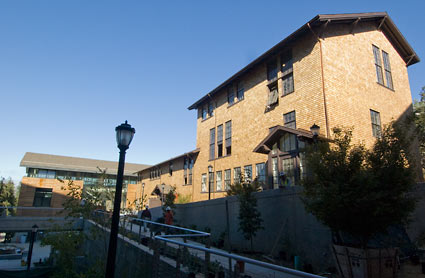Campus to celebrate grand opening of Blum Hall today at 2 p.m.
Richard C. Blum Hall, a new headquarters at UC Berkeley for creating innovative solutions to global poverty, will open its doors to the public today (Friday, Oct. 8). Former U.S. Secretary of State George Shultz will deliver the keynote address at the dedication ceremony, which starts at 2 p.m.
October 8, 2010
Richard C. Blum Hall, a new headquarters at the University of California, Berkeley, for creating innovative solutions to global poverty, will open its doors to the public today (Friday, Oct. 8).

Blum Hall now houses the 4-year-old Blum Center. (Steve McConnell / NewsCenter photo)
Former U.S. Secretary of State George Shultz will deliver the keynote address at the dedication ceremony, which starts at 2 p.m. Tours of the building will include presentations of projects sponsored by the campus’s Blum Center for Developing Economies that include the fuel-efficient Berkeley-Darfur Stove, used by refugees in the Sudan; and the Cellscope, which harnesses mobile phone technology to detect malaria, tuberculosis and other diseases in remote areas.
A year and a half after former Vice President Al Gore and other dignitaries broke ground at the historic Naval Architecture Building on the north side of campus, a 22,000-square-foot contemporary and Craftsman-style wood, concrete and glass complex has been erected to house the four-year-old Blum Center.
Previously, the center’s operations and project teams were scattered across campus. But now they will be consolidated in what Richard Blum, the center’s founder, hopes will offer a “collaborative” workspace for student innovators and their faculty mentors.
“This building is for the students who remind us every day that Cal can be a driving force for positive change in the world,” said Blum, a San Francisco financier, philanthropist and UC regent. He has led the $18 million effort to construct a home for the center that he launched at UC Berkeley in 2006 with a $15 million gift.
The Blum Center for Developing Economies’ dual mission is to adapt cutting-edge technologies to solve real-world problems while educating the next generation of leaders in the fight against global poverty. The center’s Global Poverty and Practice minor is the fastest-growing minor on campus, with more than 500 students declaring it their secondary academic field of concentration. In addition to taking courses, these students participate directly in poverty alleviation efforts in more than 50 countries.
“In four short years, we’ve seen the glimmer of an idea for a center focused on poverty alleviation come into being in a truly remarkable way,” Blum said. “The interest and enthusiasm of students has been amazing, and we needed a place to support their incredible talent and energy.”
Flanked by the weathered Northgate Hall, which houses the Graduate School of Journalism, and the College of Engineering’s Sutardja Dai Hall, the Blum Hall complex integrates both Craftsman and modernist architecture.
A new three-story wing is attached to the renovated Naval Architecture Building by a network of plazas, terraces and bridges that also link to Sutardja Dai Hall, where the Center for Information Technology Research in the Interest of Society (CITRIS) is developing safe water and mobile phone technologies in conjunction with the Blum Center.
The wing’s energy-efficient features include pitched roofs to keep the warm air high above the work areas, operable windows that promote the flow of fresh air, cedar shingles that provide maximum weather and sound insulation and daylight sensors that make the most of natural light. Its upper levels offer views of the Campanile and, on a clear day, San Francisco Bay.
The original Naval Architecture Building was designed by John Galen Howard in 1914 and is listed on the National Register of Historic Places. California architect Julia Morgan, best known for her work on Hearst Castle, kept a studio there. Over the decades, the building has housed numerous academic programs, including architecture, but has not been in use for some time.
Of the building’s transformation, Blum Hall construction project manager Scott Shackleton said. “It used to be very dark inside. Now it’s light.”
Before starting construction, Shackleton, assistant dean of facilities and capital projects at the College of Engineering, had to ensure the old architecture building was free of winged inhabitants: “I can guarantee it’s raptor and bat-free,” Shackleton joked.
Under a short-term agreement, the Blum Center Foundation leased the site from the University of California and used its own management to complete the hall, which will now be gifted to the campus.
San Francisco-based Gensler Architects designed the new wing and restored the Naval Architecture Building in conjunction with Knapp Architects of San Francisco, which specializes in historic preservation. Coleman Fung, a UC Berkeley alumnus, Blum Center trustee and founder of OpenLink Financial, donated $1 million for furniture to outfit Blum Hall, which will also house the Coleman Fung Institute for Engineering Leadership.
Shultz, an economist and businessman, served as U.S. Secretary of Labor and Secretary of the Treasury in the Nixon Administration, and as Secretary of State in the Reagan Administration. He is currently a distinguished fellow at Stanford University’s Hoover Institution. Shultz is also a trustee of the Blum Center, and is helping to guide the center’s efforts to help the nearly 3 billion people around the world who live on less than $2 a day.